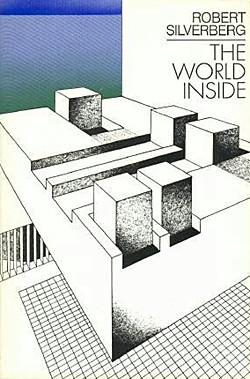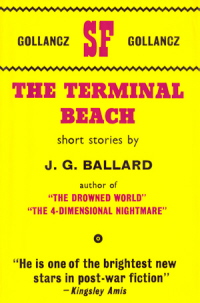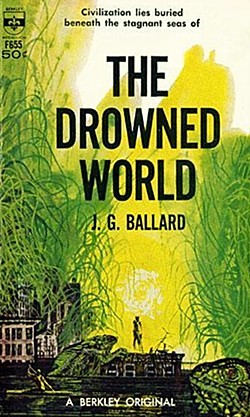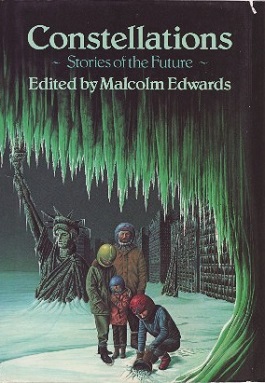Related Research Articles

James Graham Ballard was an English novelist and short story writer, satirist and essayist known for psychologically provocative works of fiction that explore the relations between human psychology, technology, sex and mass media. Ballard first became associated with New Wave science fiction for post-apocalyptic novels such as The Drowned World (1962), but later courted political controversy with the short-story collection The Atrocity Exhibition (1970), which includes the story "Why I Want to Fuck Ronald Reagan" (1968), and the novel Crash (1973), a story about car-crash fetishists.
The New Wave was a science fiction style of the 1960s and 1970s, characterized by a great degree of experimentation with the form and content of stories, greater imitation of the styles of non-science fiction literature, and an emphasis on the psychological and social sciences as opposed to the physical sciences. New Wave authors often considered themselves as part of the modernist tradition of fiction, and the New Wave was conceived as a deliberate change from the traditions of the science fiction characteristic of pulp magazines, which many of the writers involved considered irrelevant or unambitious.
Utopian and dystopian fiction are subgenres of speculative fiction that explore social and political structures. Utopian fiction portrays a setting that agrees with the author's ethos, having various attributes of another reality intended to appeal to readers. Dystopian fiction offers the opposite: the portrayal of a setting that completely disagrees with the author's ethos. Some novels combine both genres, often as a metaphor for the different directions humanity can take depending on its choices, ending up with one of two possible futures. Both utopias and dystopias are commonly found in science fiction and other types of speculative fiction.

Soylent Green is a 1973 American dystopian thriller film directed by Richard Fleischer, and starring Charlton Heston, Leigh Taylor-Young, and Edward G. Robinson in his final film role. It is loosely based on the 1966 science-fiction novel Make Room! Make Room! by Harry Harrison, with a plot that combines elements of science fiction and a police procedural. The story follows a murder investigation in a dystopian future of dying oceans and year-round humidity caused by the greenhouse effect, with the resulting pollution, depleted resources, poverty, and overpopulation. In 1973, it won the Nebula Award for Best Dramatic Presentation and the Saturn Award for Best Science Fiction Film.

The World Inside is a science fiction novel by American writer Robert Silverberg, published in 1971. The novel originally appeared as a series of shorter works in 1970 and 1971, all but one published in Galaxy, including the Hugo nominated novella "The World Outside". The World Inside was nominated for a Hugo Award in 1972, although Silverberg declined the nomination.

The Terminal Beach is a collection of science fiction short stories by British author J. G. Ballard, published in 1964.

Make Room! Make Room! is a 1966 science fiction novel written by Harry Harrison exploring the consequences of both unchecked population growth on society and the hoarding of resources by a wealthy minority. It was originally serialized in Impulse magazine.

The Drowned World (1962), by J. G. Ballard, is a British science fiction novel that depicts a post-apocalyptic future in which global warming, caused by increased solar radiation, has rendered uninhabitable much of the surface of planet Earth. The story follows a team of scientists who are researching the environmental developments that occurred in the flooded city of London. The novel is an expansion of the novella "The Drowned World", which was first published in Science Fiction Adventures magazine, in the January 1962 issue, Vol. 4, No. 24.

The 4-Dimensional Nightmare, also known as Voices of Time, is a collection of science fiction short stories by British writer J. G. Ballard, published in 1963 by Victor Gollancz.
"The Voices of Time" is a dystopian science fiction short story by British author J. G. Ballard. It was first published in the October 1960 edition of New Worlds, and later in the 1962 collection The Voices of Time and Other Stories. It is an early example of the Inner Space type of story which drove the New Wave movement in the 1960s. Its primary theme is one which was common in the New Wave, that of entropy and the breakdown of all things.
The Complete Short Stories of J. G. Ballard: Volume 1 is a short story collection by J. G. Ballard, published in 2006.
"The Concentration City" is a dystopian short story by British author J. G. Ballard, first published, under the title "Build-Up", in New Worlds volume 19 number 55 in January 1957. It was reprinted in the collections Billennium and Chronopolis and later, under its revised title, in The Disaster Area and was also included in The Complete Short Stories of J. G. Ballard: Volume 1 and The Complete Stories of J.G. Ballard.
"Track 12" is a short story by British author J. G. Ballard, it first appeared in the April 1958 edition of New Worlds. It then appeared in Penguin Science Fiction in 1961, Passport to Eternity, The Venus Hunters, The Overloaded Man, and later in The Complete Short Stories of J. G. Ballard: Volume 1.
"Studio 5, The Stars" is a short story by British author J. G. Ballard. First appearing in the February 1961 edition of Science Fantasy ; it was reprinted in the collection Billennium the following year. It later appeared in The Four-Dimensional Nightmare (1964), Vermilion Sands (1971) and The Complete Short Stories of J. G. Ballard (2006).
"Deep End" is a short story written in 1961 by British author J. G. Ballard. It first appeared in the May 1961 edition of New Worlds and then in the 1962 collection The Voices of Time and Other Stories followed by The Complete Short Stories of J. G. Ballard: Volume 1 in 2006. The tale is typical of Ballard's dystopian science fiction.
"Minus One" is a short story by British author J. G. Ballard; it was first published in the June 1963 edition of Science Fantasy. It was later reprinted in the 1967 collection The Disaster Area, and then later in the larger The Complete Short Stories of J. G. Ballard: Volume 1 anthology (2006).
"The Sound-Sweep" is a short story by British writer J. G. Ballard. It was first published in Science Fantasy, Volume 13, Number 39, February 1960 and was reprinted in the collection The Four-Dimensional Nightmare.

Climate fiction is literature that deals with climate change. Generally speculative in nature but inspired by climate science, works of climate fiction may take place in the world as we know it, in the near future, or in fictional worlds experiencing climate change. The genre frequently includes science fiction and dystopian or utopian themes, imagining the potential futures based on how humanity responds to the impacts of climate change. Climate fiction typically involves anthropogenic climate change and other environmental issues as opposed to weather and disaster more generally. Technologies such as climate engineering or climate adaptation practices often feature prominently in works exploring their impacts on society.

Tales in Space is an anthology of science fiction short stories edited by Peter Crowther. It was first published as a trade paperback by White Wolf Publishing in April 1998. It was issued as a companion to Three in Space from the same publisher; the two books followed up a similar pair, Three in Time and Tales in Time, published in 1997.

Constellations: Stories of the Future (1980) is a science fiction anthology of short stories edited by Malcolm Edwards and published by Gollancz.
References
- ↑ "Internet Database of Speculative Fiction". The Terminal Collection. Retrieved February 24, 2023.
- ↑ Ballard, J. G. (1962). "Billenium".